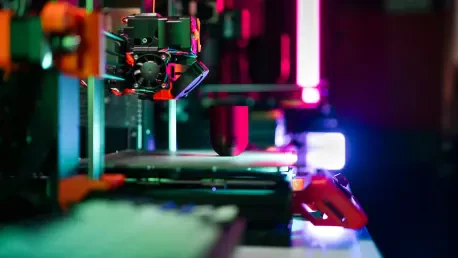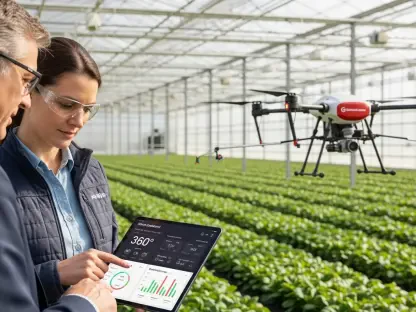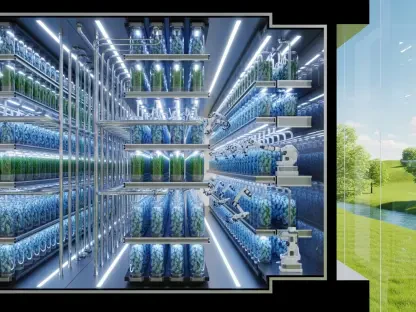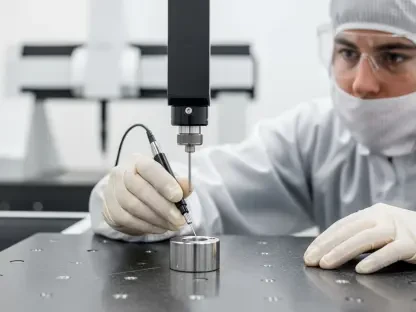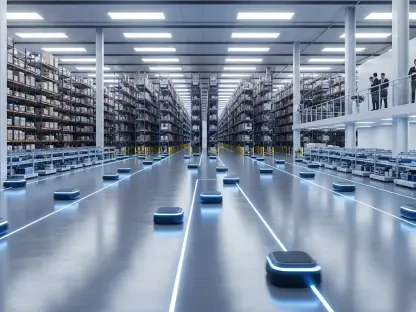Metal 3D printing, often referred to as additive manufacturing (AM), stands as a revolutionary force in industries such as aerospace and energy, offering the ability to craft intricate designs and materials with unparalleled properties. Despite its transformative potential, the technology faces significant obstacles that hinder its widespread adoption. Inconsistent part quality and a limited grasp of how materials react under extreme heat create a frustrating “black box” scenario, where internal processes remain hidden, often resulting in defects and unreliable outcomes. At Lawrence Livermore National Laboratory (LLNL), a dedicated team of researchers is tackling these challenges head-on with pioneering sensor technologies. Their goal is to illuminate the obscured dynamics of metal AM in real-time, providing a clearer path to consistent, high-quality production. This breakthrough effort not only promises to enhance manufacturing precision but also to reshape how industries approach complex fabrication challenges.
Peering into the Hidden Dynamics of Metal AM
Unraveling the Challenges of Heat-Driven Processes
Metal 3D printing, particularly through methods like laser powder-bed fusion (LPBF), relies on the application of intense heat to fuse metal powders into solid structures, a process that holds both promise and peril. This heat, while crucial for binding materials, often behaves unpredictably, leading to issues such as weak bonding, structural defects, and inconsistent quality across parts. As heat diffuses into previously printed layers, it alters material properties in ways that are difficult to anticipate or manage without direct observation. Manufacturers frequently find themselves in the dark, unable to ensure the integrity of a final product without extensive post-print testing. This lack of visibility into the printing process creates a persistent barrier, preventing metal AM from meeting the stringent demands of high-stakes applications where failure is not an option. Addressing this gap requires innovative tools capable of capturing the real-time behavior of materials under such extreme conditions, a challenge that LLNL is determined to overcome with advanced technological solutions.
The urgency to solve these heat-related challenges cannot be overstated, as the implications extend across industries reliant on precision and durability. Traditional inspection methods often fall short, either unable to withstand the harsh printing environment or limited to surface-level analysis that misses critical internal flaws. LLNL’s nondestructive evaluation (NDE) group is redefining the approach by developing sensors and techniques tailored to the unique demands of metal AM. These tools aim to go beyond mere detection, offering a window into subsurface transformations such as temperature fluctuations and structural shifts as they occur. By focusing on the root causes of inconsistency—namely, the unpredictable response of metals to thermal stress—this research seeks to establish a foundation for reliable production. The ability to monitor and understand these hidden dynamics could transform metal 3D printing from an experimental process into a trusted manufacturing standard, unlocking its full potential for industrial use.
Innovations in Sensor Technology
Among the most promising advancements at LLNL is the development of eddy current sensors, which utilize magnetic fields to measure changes in a metal’s electrical conductivity—a property closely tied to temperature. This method provides a real-time view of internal heat patterns, a critical factor in preventing defects during printing. Unlike conventional tools that struggle with the high-temperature conditions of metal AM, these sensors offer a deeper look into the material’s behavior without causing any damage. Initial experiments have demonstrated encouraging results, with validations conducted alongside academic partners and findings published in esteemed scientific journals. These early successes highlight the potential of eddy current sensors to revolutionize quality control, ensuring that each layer of a print adheres to precise specifications. As testing moves toward more realistic industrial scenarios, the insights gained could pave the way for broader application in manufacturing environments.
Beyond eddy current technology, LLNL is exploring a diverse array of NDE methods to create a comprehensive toolkit for metal AM monitoring. High-speed synchrotron X-ray imaging, for instance, captures detailed visuals of how materials evolve under heat, revealing subtle shifts that could lead to structural weaknesses. Other approaches, such as ultrasound and millimeter wave signatures, target specific aspects like liquid metal droplet behavior and overall material uniformity. Each technique contributes a unique perspective, ensuring that no critical detail escapes scrutiny during the printing process. This multifaceted strategy reflects an understanding that a single solution cannot address all the complexities of metal AM; instead, a combination of cutting-edge tools is essential for achieving consistent results. By integrating these diverse methods, LLNL aims to build a robust framework for monitoring that can adapt to the varied challenges of additive manufacturing, ultimately enhancing trust in the technology across critical sectors.
The Power of Real-Time Insights
Monitoring the Unseen
Real-time monitoring represents a pivotal goal in the evolution of metal AM, and LLNL’s advanced sensors are turning this vision into reality with remarkable precision. Unlike traditional tools such as infrared cameras, which are confined to observing surface-level changes, these innovative NDE methods penetrate deeper, capturing the internal turbulence of heat and material transformation as it unfolds. This capability is not merely about identifying flaws after they occur; it’s about preempting them, allowing for immediate adjustments during the printing process. Such proactive oversight ensures that every layer of a component meets rigorous standards, especially for applications where safety and reliability are paramount. Industries like aerospace, which demand flawless performance from every part, stand to benefit immensely from this level of control. The ability to see and respond to the unseen dynamics of metal AM marks a significant leap forward, bridging the gap between experimental technology and practical, industrial use.
The impact of real-time monitoring extends beyond defect prevention, offering a deeper understanding of the intricate processes at play within metal 3D printing. By collecting data on temperature variations, structural evolution, and material interactions as they happen, LLNL’s sensors provide invaluable insights that were previously out of reach. This information can be used to refine printing techniques, ensuring greater consistency across batches and reducing the likelihood of costly failures. Moreover, the ability to observe subsurface changes in real-time opens the door to immediate process optimization, allowing manufacturers to tweak parameters like laser intensity or powder distribution on the fly. This dynamic approach to quality assurance could redefine standards in additive manufacturing, making it a viable option for producing complex components in high-stakes environments. As these monitoring capabilities continue to advance, they promise to instill confidence in metal AM, transforming it into a cornerstone of modern production.
Harnessing Data for Intelligent Systems
The data generated by LLNL’s sensors holds transformative potential when paired with cutting-edge computational tools like machine learning algorithms. Envision a future where 3D printers are not just reactive but predictive, capable of detecting potential errors before they manifest and adjusting operations in real-time to maintain quality. By integrating sensor feedback with intelligent systems, manufacturers could dynamically alter variables such as heat levels or material flow mid-print, effectively eliminating defects at their source. This level of automation would drastically reduce failure rates, saving time and resources while boosting confidence in the reliability of AM-produced parts. Such advancements are particularly crucial for industries where even minor imperfections can have catastrophic consequences, ensuring that every component meets exacting standards. The fusion of real-time data and machine learning represents a bold step toward smarter manufacturing, redefining what’s possible in metal AM.
Furthermore, the insights derived from sensor data are set to enhance the broader ecosystem of additive manufacturing through improved simulations and predictive models. These tools allow researchers and engineers to anticipate how materials will behave under various conditions, fine-tuning processes before a single print begins. By leveraging the detailed information captured during real-time monitoring, simulations can become more accurate, reflecting the true complexities of metal AM rather than relying on generalized assumptions. This predictive capability not only minimizes waste from failed prints but also accelerates the development of new techniques and materials tailored for specific applications. As machine learning continues to evolve alongside NDE technologies, the potential for fully autonomous printing systems comes into sharper focus, promising a future where human intervention is minimized, and precision is maximized. This synergy of data and technology is poised to elevate metal AM to new heights of efficiency and reliability.
Collaboration and Future Horizons
Building a Network of Innovation
LLNL’s groundbreaking work in metal AM is amplified through strategic collaborations with leading institutions such as Michigan State University, Pennsylvania State University, Argonne National Laboratory, and the University of Colorado, Boulder. These partnerships bring together a wealth of expertise, combining diverse perspectives to push the boundaries of NDE and sensor technology. Joint efforts have already produced significant achievements, including the validation of sensor systems like eddy current technology and the publication of research in top-tier journals. Such collaborative endeavors ensure that innovations are rigorously tested and refined, drawing on shared resources to simulate real-world industrial conditions. By fostering this network of knowledge exchange, LLNL is not only accelerating the pace of discovery but also ensuring that solutions are practical and scalable for widespread adoption. This collective approach underscores the importance of unity in tackling the complex challenges of additive manufacturing.
The strength of these collaborations lies in their ability to bridge theoretical research with tangible applications, creating a robust pipeline for innovation in metal AM. Working alongside academic and research partners, LLNL can explore a wider range of experimental conditions, from non-uniform heating to rapid printing timescales, that mimic the demands of actual production environments. This rigorous testing phase is critical for validating the effectiveness of new NDE techniques, ensuring they perform reliably under the stresses of industrial use. Moreover, shared findings published in scientific literature contribute to a growing body of knowledge that benefits the entire field, inspiring further advancements and refinements. The collaborative spirit driving this research reflects a broader commitment to overcoming the “black box” nature of metal 3D printing, uniting experts in a shared mission to transform a promising technology into a dependable manufacturing solution for critical industries.
Shaping Tomorrow’s Manufacturing
The long-term implications of LLNL’s sensor advancements are evident in the strides made to demystify the opaque processes of metal 3D printing, setting the stage for its acceptance in safety-critical applications. By providing clarity on internal dynamics, these technologies help build trust in AM-produced components for use in aircraft, energy systems, and other high-risk sectors where precision is non-negotiable. The detailed data captured through NDE methods also supports the refinement of simulations and predictive models, enabling manufacturers to optimize processes and significantly reduce waste from defective prints. This focus on reliability and efficiency marks a turning point, ensuring that metal AM can meet the exacting standards required for industrial integration. Looking ahead, these efforts lay a crucial foundation for a future where additive manufacturing becomes synonymous with dependability and innovation.
Reflecting on the progress achieved, it is clear that the integration of machine learning with sensor data offers actionable pathways for the evolution of metal AM. The ability to detect and correct errors in real-time through intelligent systems points to a manufacturing landscape where automation plays a central role, minimizing human oversight while maximizing precision. Additionally, the collaborative frameworks established with research institutions provide a blueprint for sustained innovation, encouraging ongoing exploration of new NDE techniques and their applications. Moving forward, the focus should remain on scaling these solutions to diverse industrial contexts, ensuring accessibility for manufacturers of all sizes. The journey of unlocking metal AM’s potential highlights the power of interdisciplinary effort and technological synergy, charting a course toward a manufacturing era defined by accuracy, efficiency, and boundless possibility.
